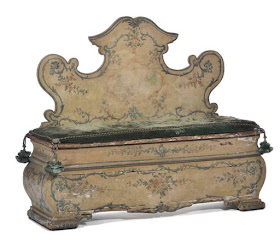I have loved these fabulous painted benches for years and am surprised to see that most people know very little about them. Here is a bit of history. When a cassone or "large chest" belonging to rich Italian merchants and aristocrats in the Late Middle Ages was provided with a high paneled back, it evolved into a cassapanca, "chest-bench", which was the forerunner of the sofa. The Italian Renaissance painted cassapanca ( kas-uh-pang-kuh) , while functioning as piece of furniture, was also a canvas for the exuberant decoration of painters from the Baroque era. These artists would cover the entire surface of the bench and back panel with crests, legendary figures and trompe-l’oeil, French for "fool the eye". Sometimes called illusionist furniture, this style of painted furniture dates back to the early Renaissance where ceilings, walls, and even furniture was painted to portray three dimensional architectural and sculptural elements.
A surviving painted cassapanca from the Italian Renaissance period is worth a great deal of money. Even the later reproductions are very expensive. Not something you can decorate with everyday! They are, however, quite lovely and I believe worth a blog post so that you can learn a bit about them and enjoy the "eye candy".
The combination of two pieces of furniture, a panca (bench) and a cassone, (low chest with a lid), a painted cassapanca was usually the pièce de résistance of the Italian home.
An Italian Renaissance painted cassapanca and a pair of torcheres from the first quarter of the 18th century. This suite would have been a prized possession then and certainly today is a treasure.
This cassapanca is elaborately painted overall in trompe-l’oeil decoration. The back features a central framed medallion of Hercules in grisaille flanked by boldly painted tritons and is beneath a grotesque masque.
The painted cassapanca is an example of illusionist painting in Italian interiors that dates back to the early Renaissance. Illusionism was a highly valued, deceptive style of painting that depicts architectural details and scenes from nature so realistically that they seem three dimensional.
The Italian painted cassapanca is a remarkable piece of furniture that is at home in grand interiors as well as rustic European country estates.
1stdibs.co
Sometimes called a marriage chest, the cassapanca is a rich and showy Italian type of chest. You could lift the seat for storage underneath. These painted Italian beauties were often given as part of marriage dowries and would be given to the bride during the wedding. It was usually the bride's parent's contribution to the wedding.
toscanantiquaria.it
These lovely Renaissance painted pieces were permanent
fixtures in the main public room of a palazzo. A cassapanca was part of what was considered "unmovables", things left in place even if the palazzo passed to another family.
These lovely Renaissance painted pieces were permanent
fixtures in the main public room of a palazzo. A cassapanca was part of what was considered "unmovables", things left in place even if the palazzo passed to another family.
source unknown
An 18th to 19th century Italian painted cassapanca.
An Italian Renaissance painted cassapance and antique carved panel in the home of Interior Designer Lars Bolander and his wife Nadine.
In aristocratic Italian homes a pair of Italian painted cassepanche often adorned the entrance halls of palazzi.
The Italian Renaissance cassapanca was usually painted in Trompe l'oeil style which is an art form rich in imagery and illusion and gives the appearance of three-dimensional realism. It flourished from the Renaissance onward.
One could commission their cassapanca to be painted in a simpler style...........
........or in exuberant painting and detail.
Trompe l' oeil was not the only art style used in painting a cassapanca. Many were hand painted with floral sprays, volutes, scrolls, and garlands of fruit and flowers.
An astonishing painted trompe l’oeil cassapance featuring wonderful architectural elements and a colorful family crest against a black background.
Since it was usually set on a dais that included one or two steps and was quite extraordinary in form, the Italian painted cassapanca like this one would have enjoyed a prominent position in the home and would be where the master of the house "held court".
Photography by Kotomi Yamamura, http://www.kotomicreations.com
When painted one color or even left natural, an Italian cassapanca still exudes elegance even in rough luxe style.
David Michael Miller Associates, source photo credit Bill Timmerman
Click here to see the previous post
http://eyefordesignlfd.blogspot.com/2016/04/decorate-spanish-colonial-old-hollywood.html
This blog post was published by Lisa Farmer



























